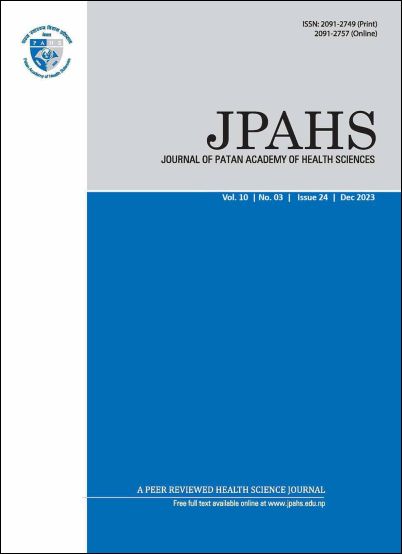Pattern of oro-dental disease in dental clinic of a tertiary care center
DOI:
https://doi.org/10.3126/jpahs.v10i3.62525Keywords:
dental caries, gingivitis/periodontitis, oro-dental diseases, tertiary care centerAbstract
Introduction: The oro-dental diseases are major public health problem throughout the population in Nepal and other countries of the world. It affects people throughout their lifetime. Unhealthy lifestyles, environment and oral health related behavior are the primary causes of oro-dental diseases. We aimed to study the descriptive variables related to oro-dental dental diseases amongst patients attending tertiary care center.
Method: A three-year data (April 2019 to April 2022) of patients registered for the treatment of oro-dental diseases in the record book of dental department of Patan Hospital were collected retrospectively. The collected data were entered in Microsoft Excel, and statistical analysis was carried out by using Statistical Package for the Social Science (SPSS) version 16.
Result: In the study, 15,879 patients were included; among them 8,652(54.49%) were female and 7,227(45.51%) were male. The most prevalent oro-dental disease was gingivitis/periodontitis 5,076(31.96%) followed by dental caries 5,028(31.66%), abrasion 3,525(22.2%), malocclusion 951(5.99%), impaction 585(3.68%), pulpitis 384(2.42%) and edentulous 330(2.08%). In male, majority 1,800(24.9 %) belonged to 60 years and above age group, in female, majority 1,749 (20.21 %) belonged to 20-29 y.
Conclusion: The most prevalent oro-dental diseases was gingivitis/periodontitis followed by dental caries, abrasion, malocclusion, impaction, pulpitis and edentulous. The female patients had more oro-dental problems than males.
Downloads
Downloads
Published
How to Cite
Issue
Section
License
© Journal of Patan Academy of Health Sciences
Submission of the manuscript means that the authors agree to assign exclusive copyright to JPAHS. All authors must sign a Copyright Transfer and Author Agreement form upon submission of the manuscript to the Journal. The work shall not be published elsewhere in any language without the written consent of JPAHS. The articles published in this journal are protected by copyright which covers translation rights and the exclusive rights to reproduce and distribute all of the articles printed in the journal.




